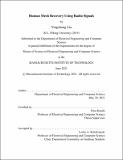| dc.contributor.advisor | Katabi, Dina | |
| dc.contributor.author | Liu, Yingcheng | |
| dc.date.accessioned | 2022-01-14T14:46:04Z | |
| dc.date.available | 2022-01-14T14:46:04Z | |
| dc.date.issued | 2021-06 | |
| dc.date.submitted | 2021-06-24T19:26:57.456Z | |
| dc.identifier.uri | https://hdl.handle.net/1721.1/139037 | |
| dc.description.abstract | This thesis presents RF-Avatar, a neural network model that can estimate 3D meshes of the human body in the presence of occlusions, baggy clothes, and bad lighting conditions. We leverage that radio frequency (RF) signals in the WiFi range traverse clothes and occlusions and bounce off the human body. Our model parses such radio signals and recovers 3D body meshes. Our meshes are dynamic and smoothly track the movements of the corresponding people. Further, our model works both in single and multi-person scenarios. Inferring body meshes from radio signals is a highly under-constrained problem. Our model deals with this challenge using: 1) a combination of strong and weak supervision, 2) a multi-headed self-attention mechanism that attends differently to temporal information in the radio signal, and 3) an adversarially trained temporal discriminator that imposes a prior on the dynamics of human motion. Our results show that RF-Avatar accurately recovers dynamic 3D meshes in the presence of occlusions, baggy clothes, bad lighting conditions, and even through walls. | |
| dc.publisher | Massachusetts Institute of Technology | |
| dc.rights | In Copyright - Educational Use Permitted | |
| dc.rights | Copyright MIT | |
| dc.rights.uri | http://rightsstatements.org/page/InC-EDU/1.0/ | |
| dc.title | Human Mesh Recovery Using Radio Signals | |
| dc.type | Thesis | |
| dc.description.degree | S.M. | |
| dc.contributor.department | Massachusetts Institute of Technology. Department of Electrical Engineering and Computer Science | |
| mit.thesis.degree | Master | |
| thesis.degree.name | Master of Science in Electrical Engineering and Computer Science | |
